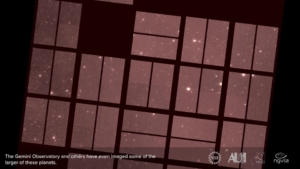

Pebbles to Planets
Five billion years ago our sun began to form within a nebula of gas and dust. Soon gas swirled and dust condensed to create a disk of material that grew around the Sun. Out of this disk, the Solar System formed. As we look into the night sky we see young stars forming with similar protoplanetary disks. Astronomers are studying the stars to understand the origins of the solar system, and how life arose on planet Earth. Radio astronomy can see cool gas and dust around young stars. ALMA has captured detailed images of protoplanetary disks. They show gaps within the disks where planets have started to form. The VLA has observed the faint radio glow of complex molecules that are the precursors of life. Optical and infrared astronomy has more than a thousand planets orbiting other stars. They have found a vast diversity of stars. The Gemini Observatory and others have even imaged some of the larger of these planets. Astronomers can study the atmospheres and temperatures of some planets. But we have only begun to answer the mysteries these distant worlds hold. To explore futher, we look to the plans for the next generation Very Large Array and the US Extremely Large Telescope program (US-ELTP). The ngVLA will study proplanetary disks in unprecedented detail. It will terrestial planets as they form, and study how the dynamics of gas and dust effect their growth and evolution. The US-ELTP will study young rocky planets that bask in the warm glow of their star and even detect water and oxygen on potentially habitable worlds. Working together, radion and optical astronomy has discovered planets around other stars, and has transformed our understanding of the solar system.

Black Holes and Neutron Stars: ngVLA Key Science Goal 5
The ngVLA will observe Black Holes and Neutron Starsin an unprecedented way. Mergers of black holes and other dense body create powerful gravitational waves. When neutron stars merge, they create powerful radio bursts. ngVLA will observe these bursts to pinpoint the source of gravitational waves. By combining radio and gravitational wave observations, we can observe how the universe is expanding the observable universe.

Understanding Gravity: ngVLA Key Science Goal 4
Ifrared telescopes have observed starts orbiting our galaxy’s central black hole for decades. The ngVLA will reveal the faint signals of pulsars that also orbit the black hole. The motion of pulsars can be measured with a million times more accuracy than that of stars. These pulsars can be used as celestial clocks to study the effects of gravity on motion and time. This will let us test Einstiens’ theory of gravity in new ways, and may provide clues to physics beyond the standard model.

Galaxy Evolution: ngVLA Key Science Goal 3
At the center of most galaxies lies a supermassive black hole. They are millions to billions times more massive than our Sun. When they consume surrounding material, they produce powerful “jets” of radio plasma. The ngVLA will peer deep into the heart of galaxies to study how these jets interact with the surrounding gas and dust. These observations will help us understand how suermassive black holes influence star formation and ultimately the growth and evolution of galaxies over cosmic time.


